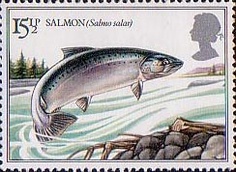At least 45 lochs around Scotland’s coast have been contaminated by toxic pesticides from fish farms that can harm wildlife and human health, according to data released by the Scottish Environment Protection Agency (Sepa). Levels of chemicals used to kill the sea lice that plague caged salmon have breached environmental safety limits more than a hundred times in the last 10 years. The chemicals have been discharged by 70 fish farms run by seven companies. The pollution has been condemned as a “toxic timebomb” by environmental campaigners, who are lodging a formal complaint with the European Commission. The fish farming industry, however, insists that it always tries to abide by the rules.
Sepa released a spreadsheet under freedom of information law showing the results of over 1,200 sampling operations at about 280 fish farms. It revealed that between 2006 and 2016 levels of anti-sea lice pesticides found in sediment 100 metres away from salmon cages exceeded environmental quality standards in 45 sea lochs and inshore waters.
They included Loch Linnhe, Loch Kishorn, Loch Nevis, Loch Ewe, Loch Torridon and ten others in Highland region. There were 11 contaminated lochs and waters in Argyll and Bute, including Loch Fyne, Loch Creran, the Firth of Lorn, and the sounds of Mull, Jura and Gigha.
Another 11 voes and firths around the Shetland islands were polluted, as were seven in the Western isles and Lamlash Bay in North Ayrshire. The companies named as responsible included Marine Harvest, Scottish Sea Farms, The Scottish Salmon Company and Grieg Seafood Shetland.
The main pesticide detected was emamectin benzoate. According to Sepa, it “is toxic to birds, mammals, fish and other aquatic organisms, particularly those living on the sea bed”. Sepa says that there is little evidence on its full effects on human health, but adds: “Exposure to emamectin benzoate may cause irritation of the respiratory tract, eyes and skin. Animal studies suggest that exposure to emamectin benzoate may also cause tremors.”
Another fish farm pesticide that breached environmental quality standards in lochs was teflubenzuron. It can harm shrimps, crabs and lobsters, and may affect human livers.
Vyvyan Howard, an emeritus professor of toxicology at Ulster University and a former government adviser on pesticides, was worried about the possible impact on health. “The main concern would be the long-term, low-dose effects,” he said. “The risk is ill-defined, and it should be better defined, particularly if there are these inadvertent releases.”
Dr Richard Luxmoore, senior nature conservation adviser to The National Trust for Scotland, warned that emamectin was a neurotoxin that could kill invertebrates and was “highly toxic” to birds and mammals. “The environmental standards have been put there for a good reason,” he said.
“It is highly worrying that they have been breached so many times. This is yet more evidence that the chemical warfare waged by fish farms against sea lice has essentially been lost and the application of toxins to kill them is spiralling out of control.”
Dr Sam Collin from the Scottish Wildlife Trust agreed emamectin was a major concern. “It’s worrying that there have been so many breaches of the standards for its use,” he said. “This particular chemical stays in the marine environment for a long time and is capable of causing harm to a wide variety of sea life, in particular invertebrates such as shellfish.”
Sepa’s spreadsheet was obtained by the anti-fish farming campaigner Don Staniford of the Global Alliance Against Industrial Aquaculture. “Sepa is permitting salmon farmers across Scotland to pollute with impunity,” he said. “Breaches of environmental standards for chemical pollution under salmon farms are now becoming standard practice as Sepa shamefully turns a blind eye.” Staniford added: “Toxic chemicals from salmon farms have flooded Scottish lochs for over three decades contaminating shellfish and the seabed. Scottish salmon farming is a toxic time-bomb.”
Salmon and Trout Conservation Scotland, which represents anglers, is referring the emamectin breaches to the European Commission in the belief that they contravene environmental law. “It appears that Sepa has been looking the other way and allowing excessive treatment chemicals to be used, which will have damaged the ecology of the sea lochs,” said the group’s Guy Linley-Adams. “Sepa must use its statutory powers to order a reduction in the number of farmed fish allowed in the cages to a level at which the fish-farmers can control sea lice and, at the same time, stay within their pollution control licences.”
The Scottish Salmon Producers’ Organisation, which represents fish farming companies, referred inquires to Sepa. “Our members at all times endeavour to operate within the terms of their consents,” said the organisation’s chief executive Scott Landsburgh. Sepa said it did not have time last week to estimate how many lochs or fish farms had breached environmental quality standards. But it explained in detail how to work out when breaches had occurred.
A Sepa spokesman pointed out that contamination found 100 metres from salmon cages was unlikely to spread a significant distance. Sampling was timed to give a “worst case” in terms of the levels of pesticide in the sediment. “Sepa’s enforcement philosophy is to use the minimum amount of formal regulation necessary to secure compliance,” he said. “An exceedance of an environmental quality standard is not in itself indicative of non-compliant or illegal activity on the part of the operator and thus a breach would not necessarily precipitate significant enforcement action.”
There were currently two instances in which fish farm licences had been changed because of pesticide pollution. “Where cases are referred to the procurator fiscal these will be reported where the case results in a conviction,” the spokesman said.
Source: The Ferret, 28 Feb 17
https://theferret.scot/45-lochs-polluted-fish-farm-pesticides/

- Login om te reageren
